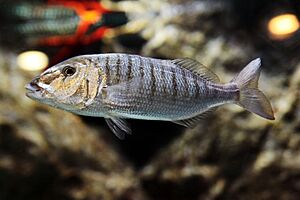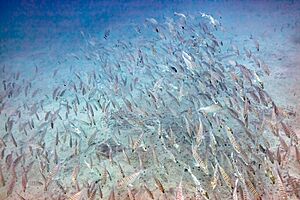Sand steenbras facts for kids
Quick facts for kids Sand steenbras |
|
|---|---|
 |
|
| Conservation status | |
| Scientific classification | |
| Genus: |
Lithognathus
|
| Species: |
mormyrus
|
| Synonyms | |
|
|
The sand steenbras or striped seabream (Lithognathus mormyrus) is a type of fish that lives in the ocean. It belongs to the Sparidae family, which includes many kinds of seabreams. You can find this fish in shallow waters of the Mediterranean Sea and the eastern Atlantic Ocean, all the way from France down to South Africa. It also lives in the Red Sea and near Mozambique in the Indian Ocean. Experts say it's a "least concern" species, meaning it's not currently in danger.
Contents
What Does a Sand Steenbras Look Like?
The sand steenbras has a body that's fairly deep from top to bottom. It can grow to be about 55 centimeters (21.5 inches) long and weigh around 1 kilogram (2.2 pounds). However, most of them are about 30 centimeters (12 inches) long.
Key Features of the Sand Steenbras
Its head is about as long as it is tall, with a slightly rounded top. The fin on its back, called the dorsal fin, has eleven strong spines and twelve to thirteen soft rays. The fins on its sides, called pectoral fins, are shorter than its head and have fifteen to seventeen soft rays. The fin underneath, called the anal fin, has three spines and ten to eleven soft rays. The sand steenbras is silver all over, and its body has about fourteen dark stripes going up and down.
Where Do Sand Steenbras Live?
This fish is found in many shallow parts of the ocean, usually at depths up to about 150 meters (490 feet).
Sand Steenbras Habitat and Location
Its home includes the Mediterranean Sea, the Black Sea, and the Sea of Azov. In the Atlantic Ocean, it lives from France down to South Africa, including the Canary Islands, Madeira, and the Cape Verde Islands. You can also find it in the Red Sea and the western Indian Ocean, from Mozambique to South Africa. Sand steenbras like to live in estuaries (where rivers meet the sea) and bays. They prefer sandy or muddy seabeds and areas with sea grass.
How Do Sand Steenbras Live and Eat?
The sand steenbras mostly eats small creatures it finds on the seabed. It's a social fish and often swims in large groups, called schools.
What Do Sand Steenbras Eat?
Their diet includes many different kinds of invertebrates. They enjoy eating snails, clams, worms, crabs, amphipods (tiny shrimp-like creatures), copepods (even smaller crustaceans), and even small sea urchins. Sometimes, they might also eat very small fish.
Sand Steenbras Life Cycle and Reproduction
The sand steenbras is a special kind of fish because it changes its sex during its life. This is called being a protandric hermaphrodite. It starts its adult life as a male. Later, it changes into a female. In the Mediterranean Sea, male sand steenbras become mature around two years old, when they are about 14 centimeters (5.5 inches) long. They then change into females when they are between four and seven years old, at a length of about 21 to 28 centimeters (8 to 11 inches).
Conservation Status
People catch sand steenbras for food in many places where it lives. However, it's not usually the main fish that fishers are trying to catch because it's quite small. The International Union for Conservation of Nature has looked at its population and decided that it is a "least concern" species. This means that its population is stable and not currently at risk.



